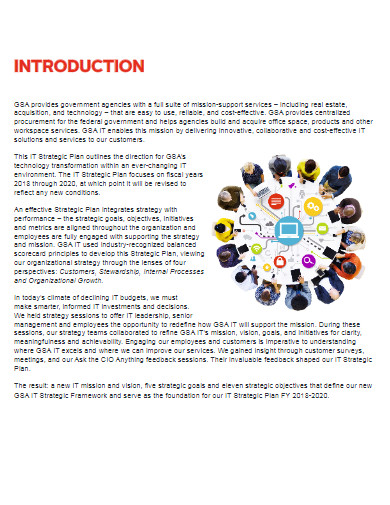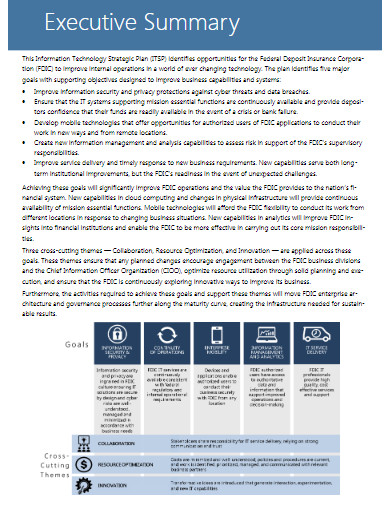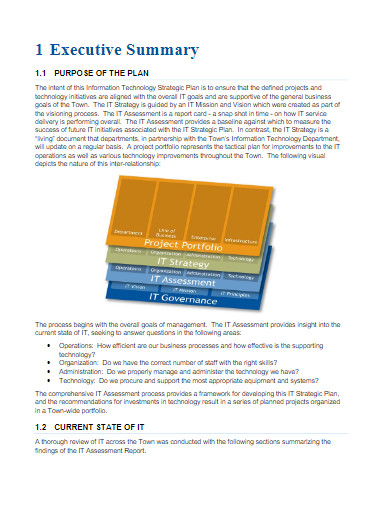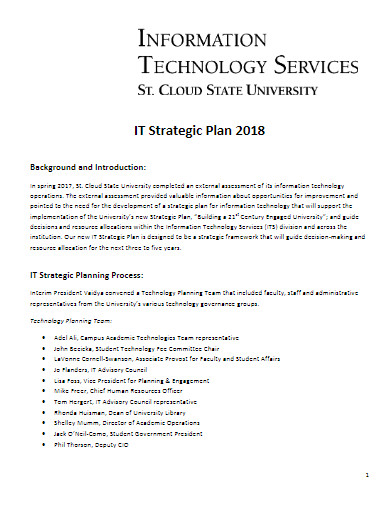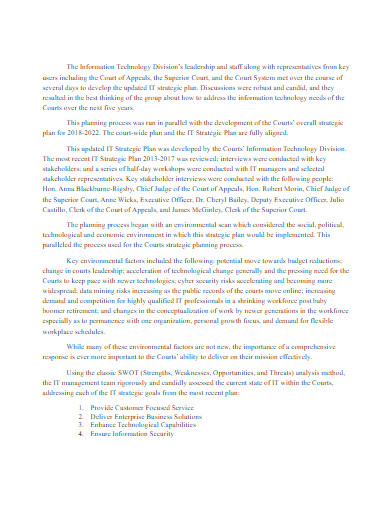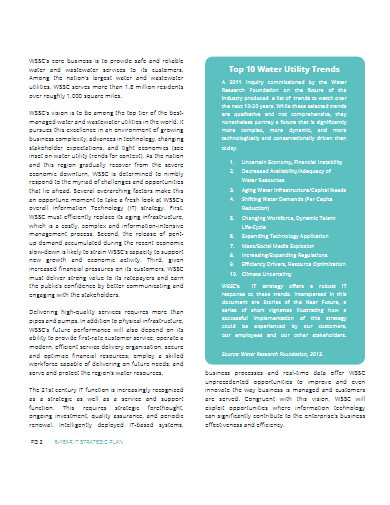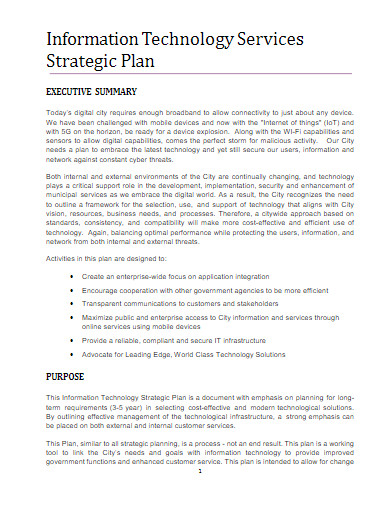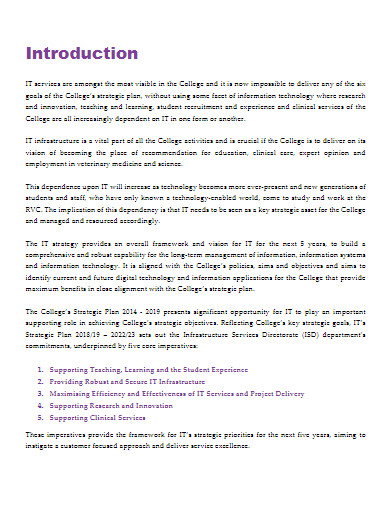10+ IT Strategy Plan Examples to Download
The information technology (IT) structure is an integral part of any company. Better designs for it can lead to better management of an organization’s internal and external operating processes. We know that every business will be facing challenges sooner or later, and we know that these challenges evolve as time passes by. Because of this, any entrepreneurs must cope up with the evolution. One way of doing so is through the transformation or modernization of the IT structures. The implementation of such projects ensures the refinement of model structures and approaches, producing modern solutions for recent and future novel issues. We can help you document this kind of undertaking. How? Check out our article and examples below!
10+ IT Strategy Plan Examples
1. IT Strategy Plan Template
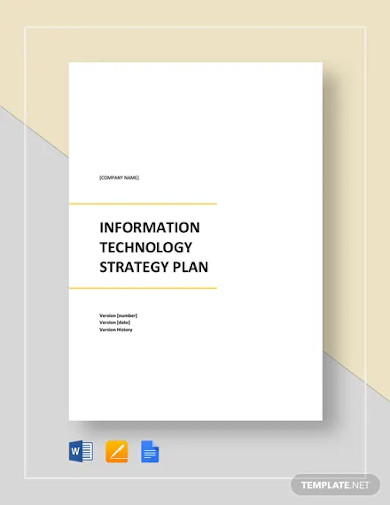
2. IT Strategic Plan Template
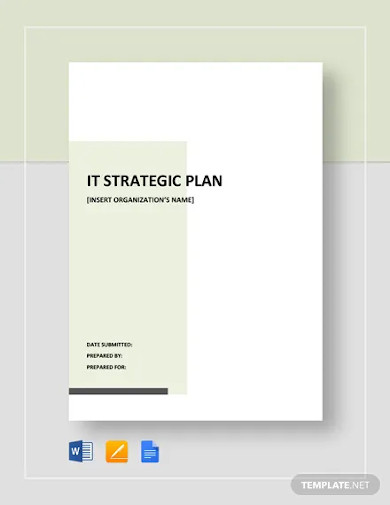
3. Sample IT Strategy Plan
4. Financial Year IT Strategy Plan
5. IT Strategic Plan Example
6. IT Business Strategy Plan
7. IT Strategic Plan Yearly
8. Information Technology Strategic Plan
9. 5-Year IT Strategic Plan
10. IT Services Strategic Plan
11. IT Strategy Plan in PDF
What Is an IT Strategy Plan
An IT strategy plan is a process document that describes an organization’s goals and objectives in the workplace, the supporting IT strategies, and execution tactics to turn those strategies into reality. Colton De Vos’s January 2020 blog for Resolute Technology Solutions Inc. shared that the coverage of such a plan depends on the company’s necessities. However, the same blog pointed out that all IT strategy plan’s content must agree with the company’s overall mission and vision statements. With that, it is safe to say that the plan is an important part of the company’s solutions, whatever issues that will arise.
Benefits of IT in Businesses
Not so long ago, most of us despised the idea of technology taking over most of our chores and jobs. In the face of all the negative connotations, the IT industry stayed true to their purpose and now provides us with the utmost convenience in many aspects of our daily lives. The same goes most especially for business organizations. Here are some of the benefits IT brings to businesses:
1. Cyber Security – IT protects all the items in your data inventory, especially those under a non-disclosure agreement (NDA) or data confidentiality agreement.
2. Efficiency – IT helps make business operations faster and more accurate.
3. Exposure – Through various online platforms, such as websites and social media, businesses have more opportunities to publicize their brands, products, and services cheaply and more effectively.
4. Revamped Communication – Through emails, mobile phones, and other technological innovations that IT brought about to businesses and individuals, communication becomes easier.
How To Organize an IT Strategy Plan
Organizing a comprehensive and well-written IT strategy plan requires hard work and a meticulous attitude. Regarding its content, it has to follow the standard document flow and has to incorporate technical writing principles. For your guidance, we encourage you to skim on our research-based outline below.
1. Align IT Goals with Business Strategy
Whether it’s about communication strategy plan, website strategy plan, maintenance strategy plan, or other business development strategy plan, you have to include an IT strategy plan on a 1:1 ratio. This means that for every planning, you have to include an IT-related agenda. The reason for this is to ensure that your IT strategy is actually a part of an overall solution.
2. Enlist the Right People
Restructuring your IT systems can be very complicated for non-IT practitioners. In view of that fact, you have to enlist the people who are suitable to carry on your strategic activities. You can consider reaching out to IT leaders or managers, IT architects, and IT analysts. Since this plan also pursues the general business objectives, you have to get in touch with business executives and financial analysts.
3. Set Appropriate Objectives
Even though this plan is just a piece of the business’s overall improvement scheme, this process document should still set out its very own set of objectives. Doing so allows both IT and other departmental managers to reassess and realign their established aims.
4. Distribute Budget Accordingly
Another challenge that you have to face in creating an IT strategy plan is formulating your IT budget. The top global research and advisory firm Gartner suggests dividing the expenditures into three categories – run, grow, and transform. IT comes in on the last category, where the budget focuses on the technological aspects.
5. Select and Apply Suitable Methodologies
Cloud-first, cloud-native, and on-premise are the basic IT strategy categories. Cloud-first is the category where strategies are set on utilizing established cloud platforms and services. On the other hand, cloud-native is when an organization creates its organization IT structure over the cloud and uses them for IT operations. The last strategy, the on-premise, refers to the IT strategy that maximizes in-house software, data storage, and other IT tools. You have to decide which among these will best fit your company and apply its principles thoroughly.
6. List Success Metrics
You have to know whether your plan is effective or not. This is why you have to set your very own list of success metrics. These metrics should include the timely delivery of deliverables, proper budget distribution, and the user-satisfaction. The list is also an important part of the documentation procedure and is a useful reference in the future.
FAQs:
What is an IT infrastructure?
An IT infrastructure refers to the elements of an IT system. They consist of software, hardware, networks, and resources. Through the infrastructure, organizations can successfully fulfill their services to clients, business partners, and employees.
What is cloud computing?
According to Microsoft Azure, cloud computing is the execution of computing services on the cloud or the internet. These services include networking, data storage, analytics, artificial intelligence, servers, and databases.
What is the difference between software and hardware?
Hardware refers to any physical devices of a computer, such as the keyboard and mouse. On the other hand, software refers to the intangible computer components, like applications and browsers.
The science behind IT is, without a doubt, one of the significant proof of how limitless human capabilities are. With so many models developed for the industry’s practitioners, both them and their clients can have various options and opportunities to mold their businesses in a more advanced and technological manner. But to successfully transform one’s IT structures, they are going to need a good set of strategies. Comic artist and video game writer Brian Reed once said, “Everything is designed. Few things are designed well.” Therefore, an IT strategy plan is highly necessary for all businesses.




